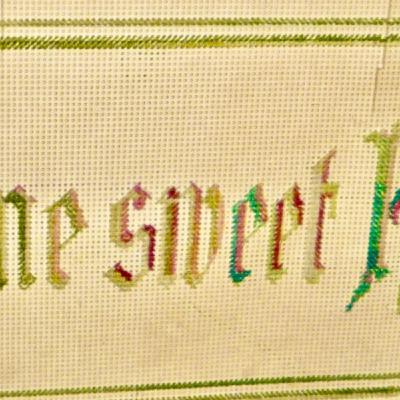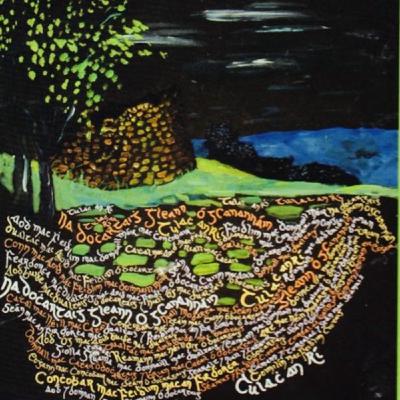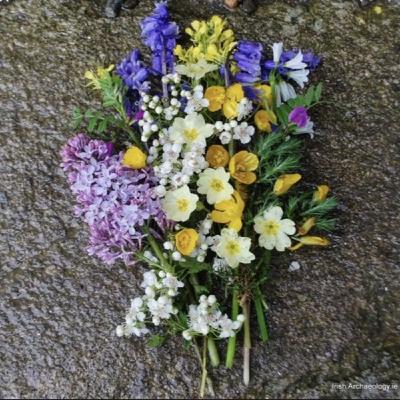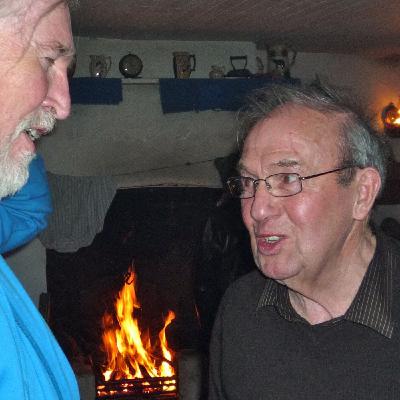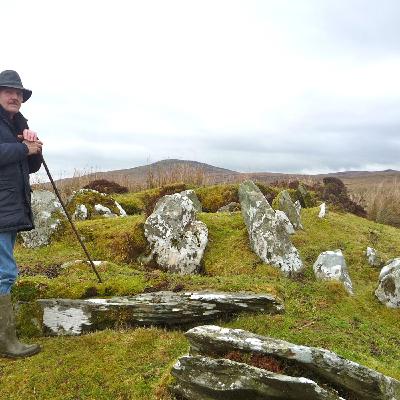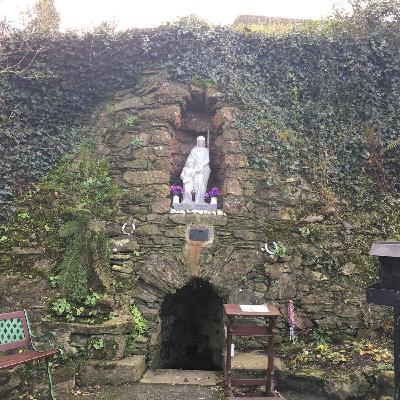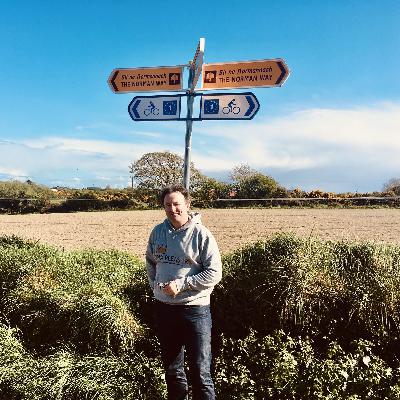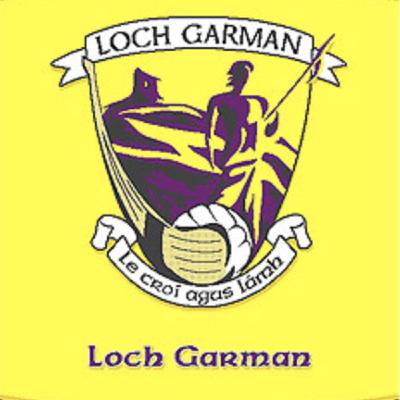Discover Racontour Archive - 2020 onwards
Racontour Archive - 2020 onwards

Racontour Archive - 2020 onwards
Author: Racontour and friends
Subscribed: 0Played: 14Subscribe
Share
© 2008-2022 Racontour Productions, all rights reserved.
Description
Hear the very best lore and stories from Ireland. Everything from folklore to rambling house tales, travel guides to idioms. Please share our posts on your social media if you enjoyed them, thanks!
426 Episodes
Reverse
A welcome from the site founder, John Ward, to the website.
A quick word to say don't be put off by the amount of details below - they're just suggestions. It's your Rambling House evening, so just do the parts that appeal.
Show host, John Ward, started by wishing a very happy Bealtaine 2021 to everyone watching on Facebook live – and a happy Cantor Maggio to our Italian friends.
The show coincided with the relaunch of the https://ramblinghouse.ie/ website. It opened with the original intro music from the 2009 radio series of Rambling House on ICR followed by Sean Beattie reading the traditional invitation poem made famous by the late Eamon Kelly in his RTÉ radio programme, The Rambling House: -
”The ricket is thatched, the fields are bare,
Long nights are here again,
The year was fine, but now ‘tis time,
To hear the ballad men,
Boul in, boul in and take a chair,
Admission here is free,
You’re welcome in the rambling house,
To hear the Seanchaí”
The roll call of the guests on the show were: -
· Mary Harte, archaeologist and broadcaster
· Sean Beattie, historian and editor
· Catherine Rhatigan, musician and producer
· Seoirse O’Dochartaigh, musician and painter
· Dessie McCallion, tour guide and oracle
· Marie and the Magerini of Fabio and Gemateo in Italy
Each gave their time generously and freely which was much appreciated. Much and all as it was enjoyed, I made the call to gather material for the other three cross-quarter days offline and at a less frenetic pace without IT gremlins abounding!
Painting is Caisleán Ghleann Ó gCanannáin, Tulaigh an Rí: Feilim” (Glennagannon Castle, Tullynaree, Carndonagh: Felim [of the 4th Race]. It was one of 17 paintings from the series called Seacht Sliocht Uí Dhochartaigh Inis Eoghain (The Seven Races of Inishowen O’Doherty), from the same year. See www.seoirse.com for more.
© 2021-2022 Racontour Productions. This clip forms part of the Celtic Calendar audio archive from Racontour Productions. Feel free to share if enjoyed, but with a credit or a social media tag to Racontour Productions please.
SPOTIFY: This platform has allowed us to be creative in ensuring you can access it on your smart phone with ease. Below are the Spotify options: -
Celtic Calendar playlist - no music, just audio of all four festivals.
Samhain folklore - music and lore for Samhain
Imbolc folklore - music and lore for Imbolc
Bealtaine folklore - music and lore for Bealtaine
Lughnasa folklore - music and lore for Lughnasa
Host John Ward tells us a bit more about the lore of Bealtaine. Recorded via Facebook Live on the 1st May 2021.
Photo from 1964 in Co. Westmeath, Ireland. Thanks to Coimisiún Béaloideasa Éireann (CBÉ) / Irish Folklore Commission in UCD.
© 2021-2022 Racontour Productions. This clip forms part of the Celtic Calendar audio archive from Racontour Productions. Feel free to share if enjoyed, but with a credit or a social media tag to Racontour Productions please.
SPOTIFY: This platform has allowed us to be creative in ensuring you can access it on your smart phone with ease. Below are the Spotify options: -
Celtic Calendar playlist - no music, just audio of all four festivals.
Samhain folklore - music and lore for Samhain
Imbolc folklore - music and lore for Imbolc
Bealtaine folklore - music and lore for Bealtaine
Lughnasa folklore - music and lore for Lughnasa
Speaker: Mary Harte
Shrine 22: saluting the Sun.
Location: 54.851216, -7.604685
Raphoe is the smallest cathedral city in Europe, but it a site of worship over a mile south of the 'city' that there stands one of the best preserved stone circles in Ireland. Reputedly older than Stonehenge, it consists of 64 standing stones out of an original 80. Beltony is a corruption of Baal tine, the fire of Baal; this suggests that the inhabitants of this area worshipped Baal, the sun god, and ruler of nature.
Tradition tells us that the principal ceremonies were performed at the summer solstice; a sacred fire was lit in the centre of the circle of stones, which represented the stars and fire of the sun god Baal. The Irish word for the month of May is 'Bealtaine', and two fires were lit on the first day of this month.
Domestic animals were then driven between the fires, so as to gain protection against diseases and the dreaded 'Evil Eye'. This custom has also been practised in other Celtic regions such as Scotland and Brittany. One romantic tale suggests that the outlying stone represents a musician, while the circle of stones represents dancers turned to stone for their revelry during the Sabbath. The more sober explanation is the alignment was used to determine astronomical alignments. We know which version we prefer to believe!
In this extended audio piece, Mary Harte knows about this hallowed place near Raphoe. Get the accompanying GPS tour here: https://www.racontour.com/dhs/
© 2021-2022 Racontour Productions. This clip forms part of the Celtic Calendar audio archive from Racontour Productions. Feel free to share if enjoyed, but with a credit or a social media tag to Racontour Productions please.
SPOTIFY: This platform has allowed us to be creative in ensuring you can access it on your smart phone with ease. Below are the Spotify options: -
Celtic Calendar playlist - no music, just audio of all four festivals.
Samhain folklore - music and lore for Samhain
Imbolc folklore - music and lore for Imbolc
Bealtaine folklore - music and lore for Bealtaine
Lughnasa folklore - music and lore for Lughnasa
Acclaimed artist Seorise O'Dochartaigh tells us about a song that has been associated with Bealtaine for centuries before signing his own version of the song from his 2018 album, Crimson Moon with his sleeve notes below - see www.seoirse.com for more on this and his other projects.
2. Samhradh! Samhradh! (Summer! Summer!)
"This song was sung on 'Baal tine' or 'May day' which was considered as the boundary day that divides Winter and Summer. On this day two separate parties met, the one dressed in the gloomy garb of Winter, the other in the gay dress of Spring. They carried on a sportive war for some time, but the Spring always obtained the victory: they then marched away in triumph, carrying branches with flowers attached to them, proclaiming and singing 'The Song of Joy' or 'We have brought the Summer in' " (Horncastle, Music of Ireland)
Thugamar Féin an Samhradh Linn (“Samhradh! Samhradh!”) was sung by groups of children in 1662 to welcome the Duke of Ormond to Dublin as the Lord Lieutenant after the Restoration. It was sung again in 1689 when Patrick Sarsfield and King James landed at Kinsale. Although it displays a certain modernity, derived from continuous oral tradition, the medieval origins of this May Day song are plainly visible. Musically, it resembles the French estampie and verelai. Its wide melodic leaps of a sixth are typical of other music from the medieval period.
In Co. Louth, this song, within living memory, used to be sung by the youths and maidens on May-Eve while they carried around the “May-Baby” (Bábóg na Bealtaine) from house to house.
The idea of interpolating the Tchaikovsky into the arrangement came about when I realized that several melodic phrases in the introductory part of the Andantino simplice to his 1st Piano Concerto were almost identical to phrases in the song. The Russian composer frequently used Ukrainian folk tunes in his works. In this case, he uses a simple, expressive melody beautifully decorated like the floral offerings of the Irish May-Day children. Tchaikovsky’s music, like the song itself, is absolutely glittering in sunshine.
Below we have listed the lyrics in both Irish and English.
Samhradh! Samhradh! (Trad. Arr. Seoirse Ó Dochartaigh)
1. Babóg na Bealtaine, Maighdean an tSamhraidh,
Suas gach cnoc is síos gach gleann,
Cailíní maiseacha bán-gheala gléasta,
Thugamar Féin an Samhradh Linn.
curfá :-
Samhradh! Samhradh! Bainne na nGamhna
Thugamar Féin an Samhradh Linn.
Thugamar linn é is cé ‘bhainfeadh dínn é?
Thugamar Féin an Samhradh Linn.
2. Thugamar linn é ón choill chraobhaigh,
Thugamar Féin an Samhradh Linn.
Samhradh buí na nóinín ngléigeal,
Thugamar Féin an Samhradh Linn.
3. Tá an fhuiseog ag seinm ‘s ag luascadh sna spéartha,
Beach agus cuileog is bláth ar na crainn,
Tá an chuach is a héanlaith’ ag seinm le pléisiúir,
Thugamar Féin an Samhradh Linn.
4. Cuileann is coll, trom is cárthainn,
Thugamar Féin an Samhradh linn
Fuinseog ghléigeal Bhéal an Átha
Thugamar Féin an Samhradh linn.
ENGLISH TRANSLATION
Babe of the May-time, Maid of the Summer,
Up every hill and down every glen.
Girls bedecked both bright and white,
We brought the summer with us.
chorus
Summer! Summer! Milk of the Calves!
We brought the summer with us.
We brought it with us and who would take it from us?
We brought the summer with us.
We brought it with us from the branchy wood.
We brought the summer with us.
Yellow summer of the bright daisies
We brought the summer with us.
The lark is singing and swinging in the skies.
Bees and insects and blossoms on the trees,
The cuckoo and chicks are singing with pleasure
We brought the summer with us.
Holly and hazel, elder and rowan,
We brought the summer with us.
The brightest ash from the Mouth of the Ford,
We brought the summer with us.
(© and ℗ Seoirse Ó Dochartaigh, IMRO 2018)
© 2021-2022 Racontour Productions. This clip forms part of the Celtic Calendar audio archive from Racontour Productions. Feel free to share if enjoyed, but with a credit or a social media tag to Racontour Productions please.
SPOTIFY: This platform has allowed us to be creative in ensuring you can access it on your smart phone with ease. Below are the Spotify options: -
Celtic Calendar playlist - no music, just audio of all four festivals.
Samhain folklore - music and lore for Samhain
Imbolc folklore - music and lore for Imbolc
Bealtaine folklore - music and lore for Bealtaine
Lughnasa folklore - music and lore for Lughnasa
Speakers: Dessie McCallion in conversation with John Ward
The boundaries of a property had to be protected on May Day. Here, we talk about some of the customs and rituals that occured to do so.
© 2021-2022 Racontour Productions. This clip forms part of the Celtic Calendar audio archive from Racontour Productions. Feel free to share if enjoyed, but with a credit or a social media tag to Racontour Productions please.
SPOTIFY: This platform has allowed us to be creative in ensuring you can access it on your smart phone with ease. Below are the Spotify options: -
Celtic Calendar playlist - no music, just audio of all four festivals.
Samhain folklore - music and lore for Samhain
Imbolc folklore - music and lore for Imbolc
Bealtaine folklore - music and lore for Bealtaine
Lughnasa folklore - music and lore for Lughnasa
Inishowen tour guide, Dessie McCallion, gives a masterclass in these three Bealtaine topics.
Fairy Dance painting by Howard Weingarden 1942-2011
© 2021-2022 Racontour Productions. This clip forms part of the Celtic Calendar audio archive from Racontour Productions. Feel free to share if enjoyed, but with a credit or a social media tag to Racontour Productions please.
SPOTIFY: This platform has allowed us to be creative in ensuring you can access it on your smart phone with ease. Below are the Spotify options: -
Celtic Calendar playlist - no music, just audio of all four festivals.
Samhain folklore - music and lore for Samhain
Imbolc folklore - music and lore for Imbolc
Bealtaine folklore - music and lore for Bealtaine
Lughnasa folklore - music and lore for Lughnasa
Prunus spinosa - Blackthorn - Draighean
Distinct from the hawthorn, the blackthorn has some notable lore on Bealtaine as Dessie McCallion tells Seoirse O'Dochartaigh in a conversation that developed.
Photo: Maxpixel
© 2021-2022 Racontour Productions. This clip forms part of the Celtic Calendar audio archive from Racontour Productions. Feel free to share if enjoyed, but with a credit or a social media tag to Racontour Productions please.
SPOTIFY: This platform has allowed us to be creative in ensuring you can access it on your smart phone with ease. Below are the Spotify options: -
Celtic Calendar playlist - no music, just audio of all four festivals.
Samhain folklore - music and lore for Samhain
Imbolc folklore - music and lore for Imbolc
Bealtaine folklore - music and lore for Bealtaine
Lughnasa folklore - music and lore for Lughnasa
Italians celebrate May Day with music and customs as well where celebrants are referred to as magerini. We were fortunate to have Marie, Fabio and Matteo to play a May Day song and tell us some lore about the day.
© 2021-2022 Racontour Productions. This clip forms part of the Celtic Calendar audio archive from Racontour Productions. Feel free to share if enjoyed, but with a credit or a social media tag to Racontour Productions please.
SPOTIFY: This platform has allowed us to be creative in ensuring you can access it on your smart phone with ease. Below are the Spotify options: -
Celtic Calendar playlist - no music, just audio of all four festivals.
Samhain folklore - music and lore for Samhain
Imbolc folklore - music and lore for Imbolc
Bealtaine folklore - music and lore for Bealtaine
Lughnasa folklore - music and lore for Lughnasa
Speaker: John Ward
May Day has long been associated as a time for gathering flowers both to ward off sinister presences, but also to celebrate the month of the Blessed Virgin Mary.
Photo: Irish Archaelogy
© 2021-2022 Racontour Productions. This clip forms part of the Celtic Calendar audio archive from Racontour Productions. Feel free to share if enjoyed, but with a credit or a social media tag to Racontour Productions please.
SPOTIFY: This platform has allowed us to be creative in ensuring you can access it on your smart phone with ease. Below are the Spotify options: -
Celtic Calendar playlist - no music, just audio of all four festivals.
Samhain folklore - music and lore for Samhain
Imbolc folklore - music and lore for Imbolc
Bealtaine folklore - music and lore for Bealtaine
Lughnasa folklore - music and lore for Lughnasa
Speaker: John Ward
Bealtaine was the most potent time of the calendar year to perform charms known in Ireland as piseogs. John Ward tells us a bit more about some of this rural witchcraft.
Photo: evidence of a piseog having taken place.
© 2021-2022 Racontour Productions. This clip forms part of the Celtic Calendar audio archive from Racontour Productions. Feel free to share if enjoyed, but with a credit or a social media tag to Racontour Productions please.
SPOTIFY: This platform has allowed us to be creative in ensuring you can access it on your smart phone with ease. Below are the Spotify options: -
Celtic Calendar playlist - no music, just audio of all four festivals.
Samhain folklore - music and lore for Samhain
Imbolc folklore - music and lore for Imbolc
Bealtaine folklore - music and lore for Bealtaine
Lughnasa folklore - music and lore for Lughnasa
There's a fair bit of folklore about the hare around the 1st of May and Dessie McCallion tells it better than most.
© 2021-2022 Racontour Productions. This clip forms part of the Celtic Calendar audio archive from Racontour Productions. Feel free to share if enjoyed, but with a credit or a social media tag to Racontour Productions please.
SPOTIFY: This platform has allowed us to be creative in ensuring you can access it on your smart phone with ease. Below are the Spotify options: -
Celtic Calendar playlist - no music, just audio of all four festivals.
Samhain folklore - music and lore for Samhain
Imbolc folklore - music and lore for Imbolc
Bealtaine folklore - music and lore for Bealtaine
Lughnasa folklore - music and lore for Lughnasa
As a nice tangent from the Bealtaine lore, Dessie and Seoirse discuss the ability of the Irish to enjoy hearing a story again and again.
Photo by John Ward features Seoirse O'Dochartaigh in blue talking to the late Sean McMahon before the legendary Border Tales second instalment from the radio series in 2009.
© 2021-2022 Racontour Productions. This clip forms part of the Celtic Calendar audio archive from Racontour Productions. Feel free to share if enjoyed, but with a credit or a social media tag to Racontour Productions please.
SPOTIFY: This platform has allowed us to be creative in ensuring you can access it on your smart phone with ease. Below are the Spotify options: -
Celtic Calendar playlist - no music, just audio of all four festivals.
Samhain folklore - music and lore for Samhain
Imbolc folklore - music and lore for Imbolc
Bealtaine folklore - music and lore for Bealtaine
Lughnasa folklore - music and lore for Lughnasa
A few thanks were needed at the end to a most enjoyable evening's entertainment. The photo was a still of Dessie McCallion where he is in his prime, out and about in Inishowen - if a Rambler's Cup were to be awarded to someone on the show for both educating and entertaining us, Dessie might just steal it by a whisker - thank you Dessie!
A big thanks to you for listening and if you enjoyed it, please spread the word on this free heritage service by following and sharing Twitter @ramblinghouseie or Facebook https://www.facebook.com/ramblinghouse2021
© 2021-2022 Racontour Productions. This clip forms part of the Celtic Calendar audio archive from Racontour Productions. Feel free to share if enjoyed, but with a credit or a social media tag to Racontour Productions please.
SPOTIFY: This platform has allowed us to be creative in ensuring you can access it on your smart phone with ease. Below are the Spotify options: -
Celtic Calendar playlist - no music, just audio of all four festivals.
Samhain folklore - music and lore for Samhain
Imbolc folklore - music and lore for Imbolc
Bealtaine folklore - music and lore for Bealtaine
Lughnasa folklore - music and lore for Lughnasa
St. Catherine was one of the Anglo-Norman’s favoured saints. It’s a well-kept verdant setting of tranquillity and has some notable architectural features. Yvonne Doyle tells us more about the site in our audio piece. She also appears in a video of the place on this link: https://youtu.be/InY4v-ymXjo
The Norman Way, Wexford, Forth and Bargy
See https://www.racontour.com/the-norman-way/ for more content on south Wexford
Email info@racontour.com
Many people hope to make it through the Pearly Gates to Paradise in the next life, but just by passing through the graveyard gates of Ishartmon, a person has technically made it there in this one, for you are standing in the heart of the townland of Paradise no less!
It served as the parish church of Ishartmon, a name that is thought to have been derived from Disert Munna - St Munna's Church. The Ishartmon parish may have been defunct before 1615 as it does not appear on Bishop Rams visitations for that year. Munna was a somewhat conservative and curmudgeonly disciplinarian afflicted with leprosy, but with the power to read his monks' minds. While not quite the ‘heavy hitter’ that minds the Pearly Gates, a full account of St. Munna's life and interesting times is in the URL link below.
The walls of this nave and chancel church, except for the north wall of the nave, have all survived complete. Some of the features to look out for are a rectangular nave window, a pointed chancel window and of course the famous double bellcote over the west gable. A number of internal features such as an aumbry, a stone shelf and a pointed chancel arch are present. Lying just inside the doorway is a circular granite font.
With three of the four main walls still intact, including the spectacular west gable wall, it is easy to visualise how this church would have looked in Norman times. Yvonne Doyle tells us about its double bellecote. She also offers a further video explanation in this link: https://youtu.be/o9jc80CoGew
The Norman Way, Wexford, Forth and Bargy
See https://www.racontour.com/the-norman-way/ for more content on south Wexford
Email info@racontour.com
Willie Murphy tell us about some of the sites to look out for when paying a must-see trip to St. Anne’s Holy Well and grotto in the village of Tomhaggard.
We have also provide a video link of both the well and a surprise at the top of the steps: https://youtu.be/S1BRy5nFMrs
Narrators: Willie Murphy and John
Video: Racontour Productions
The Norman Way, Wexford, Forth and Bargy
See https://www.racontour.com/the-norman-way/ for more content on south Wexford
Email info@racontour.com
The Norman Way is a heritage trail that runs along the south coast of County Wexford. Along this Wexford Trail, you will discover authentic medieval sites which will help you to understand the Norman way of life. These hidden gems of the Norman Way are waiting to be explored by you down quiet country lanes, in beautiful seaside villages and alongside stunning beaches. We have listed a host of points of interest on our tour, both official points of interest along the route with interpretive panels beside them and some we feel will add to your enjoyment and understanding of this remarkable part of Ireland.
The Norman Way in Wexford is a true treasure of Ireland's Ancient East. Lose yourself in this beautiful, ancient landscape as you discover the Anglo-Norman way of life in the place where it first took hold in Ireland over 800 years ago. Anyone seeking a more detailed overview of this period in history should read Billy Colfer's 2002 book, 'Arrogant Trespass', the definitive study on the Anglo-Normans in Wexford from 1169 - 1400 published by Duffry Press. We would suggest you review the tour's contents in advance and are familiar with the route. The tour is designed to run from east to west, being from Rosslare to Kilmore Quay with a nod to St. Mary's church in New Ross as well. We have also designed two tours for use as Spotify playlists, both from east to west (e2w) and west to east (w2e) depending on which way you're travelling the route.
Part Two of the tour covering Kilmore Quay to Hook Head and up to New Ross can be found on thenormanway.com. Greater details of Part One complete with videos pertaining to the route and the county can be found on our website at https://www.racontour.com/the-norman-way/
Narrators: John Ward and Heather Hadrill
With thanks to the narrators credited along the points of interest, in order of appearance: Ronan O'Flaherty, James Maloney, Monica Crofton, Gerald Meyler, James Hurley, Rose Hurley, Yvonne Doyle, Pat Hickey, Brian Matthews, Nicky Furlong, Willie Murphy, Caimin O'Brien, Breda Hayes and Catherine McLoughlin.
The Norman Way, Wexford, Forth and Bargy
See https://www.racontour.com/the-norman-way/ for more content on south Wexford
Email info@racontour.com
As you cycle along, we thought you’d like to hear more about Wexford itself, its nicknames and their origins including the famous sobriquet, ‘the Yellow Bellies’. Wexford and its denizens have many names that need some explanation to the inquisitive visitor. On the signs, it is referred to in Irish as Loch Garman and in English as Wexford, a name that has Norse provenance being 'Waesfjord' meaning 'inlet (fjord) of the mud-flats' in the Old Norse language. In pre-Norman times the are was part of the Kingdom of Uí Cheinnselaig, with its capital at Ferns. The County was formed in Norman times having been created in 1210 by King John during his visit to Ireland.
Due to its sunny climate, it grows the greatest number of strawberries on the island and is referred to as the strawberry county - look out for the strawberry fair every July in Enniscorthy. The giveaway as to why it is also referred to as 'the model county' can be found in the official motto of the county, 'Exemplar Hiberniae' and while the more formal version has it that its progressive farming methods and model farms were the envy of the rest of the island, waspish wags have suggested it was coined by the English due to Wexford ancestors' willingness to roll over and be subordinate!
More curiously, its people are commonly known as the Yellow Bellies. This sobriquet is said to have been first applied to a Wexford hurling team raised by Sir Caesar Colclough, (pronounced Cogley) which won a challenge match in Cornwall in the reign of William III of England.
The Norman Way, Wexford, Forth and Bargy
See https://www.racontour.com/the-norman-way/ for more content on south Wexford
Email info@racontour.com


